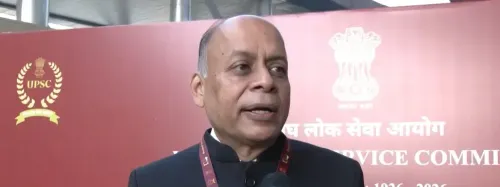Can India Transform the Semiconductor and Rare Earth Supply Landscape in Southeast Asia?
Synopsis
Key Takeaways
- India plays a crucial role in reshaping semiconductor and rare earth supply chains in Southeast Asia.
- Ongoing trade negotiations aim to balance the trade dynamics between India and ASEAN nations.
- Strategic partnerships like the India-Singapore agreement signal India's commitment to semiconductor collaboration.
- Investment in Myanmar is essential to break the Chinese monopoly on rare earth elements.
- Global geopolitical shifts are influencing trade patterns in the semiconductor industry.
New Delhi, Aug 14 (NationPress) As Southeast Asia rises as a pivotal force in the global semiconductor and rare earth mineral sectors, India is positioned to play a vital role amid the ongoing transformation of international trade and supply chain dynamics, particularly as tensions escalate due to US tariffs.
While there is no single solution to dismantling decades of Chinese supremacy, the collaborative efforts of US defense funding, EU market regulations, JOGMEC diplomacy, and India's exploration initiatives are already altering the supply landscape, according to a recent report.
JOGMEC diplomacy refers to the strategic actions taken by the Japan Organisation for Metals and Energy Security (JOGMEC) to ensure Japan's energy and resource requirements while also aiding in global resource advancement.
"Nations that blend capital with creativity and uphold credible standards have the highest likelihood of navigating the rare-earth era without falling prey to strategic vulnerabilities," states a recent publication from the Politeia Research Foundation (PRF), a non-profit organization.
India's current renegotiation of the ASEAN-India Trade in Goods Agreement (AITIGA) holds considerable promise for reshaping trade relationships and supply chain activities between India and Southeast Asian countries, as noted in the report authored by Madhav Maheshwari, a legal expert and independent policy advisor.
India has proposed duty reductions on 71% of its tariff lines, while ASEAN nations granted markedly lesser market access, with Indonesia opening merely 41% of its tariff lines, Vietnam 66.5%, and Thailand 67%.
This disparity has led to a significant imbalance, resulting in a dramatic increase in India's trade deficit with ASEAN, soaring from just $5 billion in 2010–11 to $43.57 billion in 2022–23, with semiconductors being a key import category.
"India has substantial trade volumes with Southeast Asian nations like Singapore, Malaysia, and Thailand. This imbalance, along with the exploitation of rules of origin provisions, is a primary driver behind the ongoing renegotiations," the report highlighted.
The India-Singapore Comprehensive Strategic Partnership, established in September 2024, includes a specific memorandum of understanding focused on semiconductor ecosystem collaboration, creating frameworks for strategic bilateral cooperation. The newly renegotiated agreement aims to address the challenges posed by China while facilitating Singapore’s involvement in India’s rapidly expanding market.
Malaysia is also a major trading partner for India, with total trade reaching $20 billion in 2023–24.
"The trade imbalance with Malaysia indicates that greater market access may be necessary during the renegotiation process. Vietnam's role is crucial as it epitomizes the type of manufacturing hub with which India is competing," the report noted.
"Thailand and Indonesia also significantly impact the dynamics, as they strive to position themselves as alternatives to China-dependent supply chains and products. This reflects a broader shift in the global semiconductor geopolitics. ASEAN's strategic role in global semiconductor trade networks is vital," the report emphasized.
To disrupt the Chinese monopoly on rare earth processing, particularly concerning Myanmar, "India could capitalize on this opportunity, given its proximity and aid in countering the Chinese dominance," the report suggested.
Furthermore, it stated that India and Southeast Asian nations should prioritize enhancing their investments in Myanmar.
"Initiatives such as the G7 Critical Minerals Action Plan, which enjoys broad support from Australia, India, and South Korea, should expand the scope to offer targeted assistance for Southeast Asian processing capabilities and infrastructure development," noted the PRF report.









